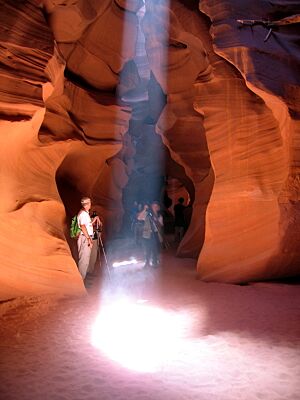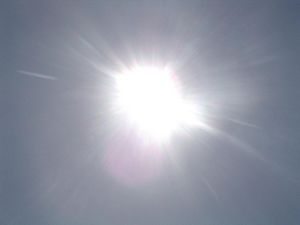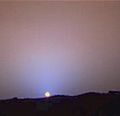Sunlight facts for kids
Sunlight is the light and energy that comes from the Sun. When this energy reaches the Earth's surface, we call it insolation. What we feel as sunlight is actually solar radiation. It is the radiation and heat from the Sun, traveling as electromagnetic waves.
The Earth's atmosphere changes how much solar radiation reaches us. As sunlight travels through the atmosphere, some of it gets absorbed (16%). Some bounces back into space (6%). Clouds reflect a lot of it (28%). About 47% of the original sunlight actually makes it to the Earth's surface.
Without sunlight, there could be no life on Earth. Plants absolutely need sunlight for a process called photosynthesis. During photosynthesis, plants use the energy from sunlight, along with water and carbon dioxide, to create glucose (a type of sugar). Plants use this glucose for their own energy, or animals eat the plants and get that energy. Sunlight helps plants grow green and strong. If a plant gets enough water but not enough sunlight, it might grow tall quickly but look yellow and weak.
Solar radiation can be both good and bad for your health. When you are in the light, your human body uses the ultraviolet part of sunlight to make its own Vitamin D. But too much ultraviolet light, especially without sunscreen, can cause sunburn and even skin cancer. The Sun angle also affects our seasons and the length of day and night. A high sun angle makes places like the tropics hot, while a low angle makes areas like the arctic very cold.
How Much Sunlight Do Planets Get?

Different planets in our Solar System receive different amounts of sunlight. Planets closer to the Sun get much more intense sunlight than those farther away. Here's a look at how much light each planet receives:
| Planet | Distance from Sun (AU) |
Solar radiation (Watts per square meter) |
|---|---|---|
| Mercury | 0.31 – 0.47 | 14,446 – 6,272 |
| Venus | 0.72 – 0.73 | 2,647 – 2,576 |
| Earth | 0.98 – 1.02 | 1,413 – 1,321 |
| Mars | 1.38 – 1.67 | 715 – 492 |
| Jupiter | 4.95 – 5.46 | 55.8 – 45.9 |
| Saturn | 9.05 – 10.12 | 16.7 – 13.4 |
| Uranus | 18.38 – 20.08 | 4.04 – 3.39 |
| Neptune | 29.77 – 30.44 | 1.54 – 1.47 |
Using Solar Energy
Solar energy is used in many ways by people around the world. Traditionally, it has been used for heating, cooking, or drying things. Today, it's also used to make electricity, especially in places where other power sources are not available. This includes remote areas on Earth or even in space. Sometimes, making electricity from sunlight can even be cheaper than using coal or oil.
Images for kids
-
Sunlight on Mars is dimmer than on Earth. This photo of a Martian sunset was imaged by Mars Pathfinder.
-
Sunlight shining through clouds, giving rise to crepuscular rays
See also
 In Spanish: Luz solar para niños
In Spanish: Luz solar para niños







